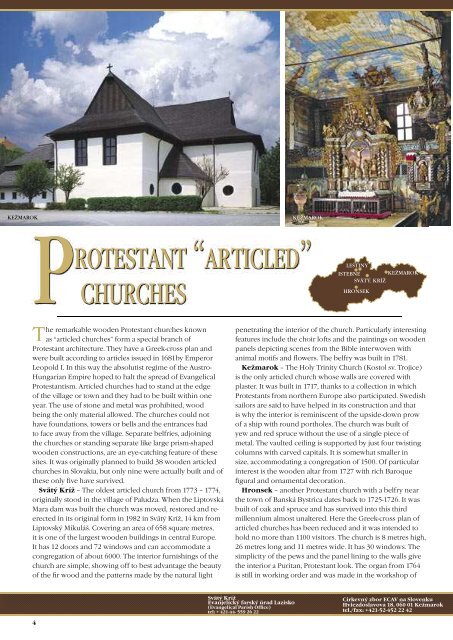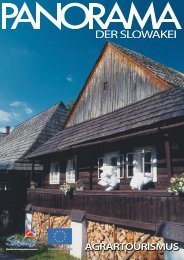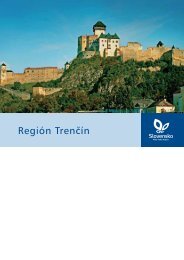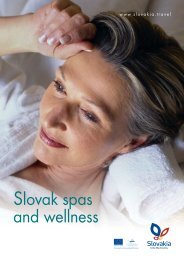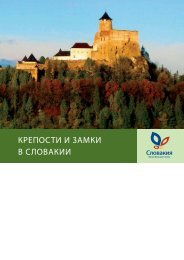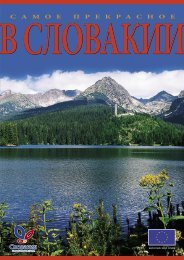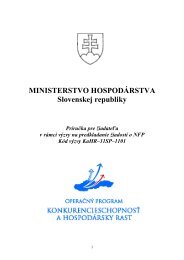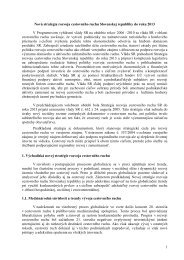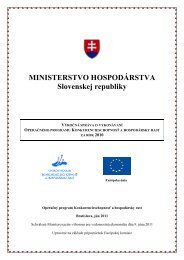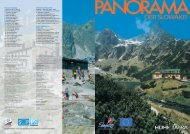Anglická verzia - SACR
Anglická verzia - SACR
Anglická verzia - SACR
You also want an ePaper? Increase the reach of your titles
YUMPU automatically turns print PDFs into web optimized ePapers that Google loves.
PROTESTANT “ARTICLED”<br />
CHURCHES<br />
KEŽMAROK KEŽMAROK LEŠTINY HRONSEK<br />
T he remarkable wooden Protestant churches known<br />
as “articled churches” form a special branch of<br />
Protestant architecture. They have a Greek-cross plan and<br />
were built according to articles issued in 1681by Emperor<br />
Leopold I. In this way the absolutist regime of the Austro-<br />
Hungarian Empire hoped to halt the spread of Evangelical<br />
Protestantism. Articled churches had to stand at the edge<br />
of the village or town and they had to be built within one<br />
year. The use of stone and metal was prohibited, wood<br />
being the only material allowed. The churches could not<br />
have foundations, towers or bells and the entrances had<br />
to face away from the village. Separate belfries, adjoining<br />
the churches or standing separate like large prism-shaped<br />
wooden constructions, are an eye-catching feature of these<br />
sites. It was originally planned to build 38 wooden articled<br />
churches in Slovakia, but only nine were actually built and of<br />
these only five have survived.<br />
Svätý Kríž – The oldest articled church from 1773 – 1774,<br />
originally stood in the village of Paludza. When the Liptovská<br />
Mara dam was built the church was moved, restored and reerected<br />
in its original form in 1982 in Svätý Kríž, 14 km from<br />
Liptovský Mikuláš. Covering an area of 658 square metres,<br />
it is one of the largest wooden buildings in central Europe.<br />
It has 12 doors and 72 windows and can accommodate a<br />
congregation of about 6000. The interior furnishings of the<br />
church are simple, showing off to best advantage the beauty<br />
of the fir wood and the patterns made by the natural light<br />
LEŠTINY<br />
ISTEBNÉ<br />
SVÄTÝ. KRÍŽ<br />
HRONSEK<br />
KEŽMAROK<br />
penetrating the interior of the church. Particularly interesting<br />
features include the choir lofts and the paintings on wooden<br />
panels depicting scenes from the Bible interwoven with<br />
animal motifs and flowers. The belfry was built in 1781.<br />
Kežmarok – The Holy Trinity Church (Kostol sv. Trojice)<br />
is the only articled church whose walls are covered with<br />
plaster. It was built in 1717, thanks to a collection in which<br />
Protestants from northern Europe also participated. Swedish<br />
sailors are said to have helped in its construction and that<br />
is why the interior is reminiscent of the upside-down prow<br />
of a ship with round portholes. The church was built of<br />
yew and red spruce without the use of a single piece of<br />
metal. The vaulted ceiling is supported by just four twisting<br />
columns with carved capitals. It is somewhat smaller in<br />
size, accommodating a congregation of 1500. Of particular<br />
interest is the wooden altar from 1727 with rich Baroque<br />
figural and ornamental decoration.<br />
Hronsek – another Protestant church with a belfry near<br />
the town of Banská Bystrica dates back to 1725-1726. It was<br />
built of oak and spruce and has survived into this third<br />
millennium almost unaltered. Here the Greek-cross plan of<br />
articled churches has been reduced and it was intended to<br />
hold no more than 1100 visitors. The church is 8 metres high,<br />
26 metres long and 11 metres wide. It has 30 windows. The<br />
simplicity of the pews and the panel lining to the walls give<br />
the interior a Puritan, Protestant look. The organ from 1764<br />
is still in working order and was made in the workshop of<br />
Master Podkonický. Two of the four enormous lime trees<br />
growing in front of the church are said to have been planted<br />
on the occasion of the consecration of the church.<br />
The articled churches in Istebné from 1686 and Leštiny<br />
from 1688 (near the town of Dolný Kubín in the Orava<br />
region) are smaller, less sophisticated types. They were<br />
built in an area restricted by the terrain and that is why<br />
there is only a hint of the shape of a cross. They are more<br />
like the older tradition of single-nave churches with oblong<br />
ground plans. In contrast to the inconspicuous exterior, their<br />
interiors are surprisingly crammed and over-ornate. The<br />
Leštiny church has been preserved in an almost authentic<br />
form. We can still admire the richly decorated sacristy,<br />
the painted marbled coffers in the ceiling and the illusory<br />
architecture on the walls. Orava’s wooden articled churches<br />
have their own inimitable charm, their artistic expression<br />
being very much influenced by folk traditions.<br />
Visiting hours<br />
Svätý Kríž<br />
1.10. - 31. 5. daily 9 am – 3 pm<br />
1.6. - 30. 9. daily 9 am – 5 pm<br />
Services every Sunday 9 am – 10 am<br />
Kežmarok<br />
1.5. - 30.10.<br />
daily 9 am – 12 am<br />
2 pm – 5 pm<br />
1.11. - 30.4. 8 am – 15 pm<br />
Tuesday, Friday<br />
10 am – 12 am<br />
2 pm – 4 pm<br />
Bookings can be made for organised groups outside the usual<br />
opening hours.<br />
Hronsek<br />
daily 10 am – 5 pm<br />
SVÄTÝ KRÍŽ<br />
SVÄTÝ KRÍŽ<br />
Svätý Kríž<br />
Evanjelický farský úrad Lazisko<br />
(Evangelical Parish Office)<br />
tel: + 421-44- 559 26 22<br />
Cirkevný zbor ECAV na Slovenku<br />
Hviezdoslavova 18, 060 01 Kežmarok<br />
tel./fax: +421-52-452 22 42<br />
Evanjelický farský úrad<br />
Krčméryho 8, Hronsek<br />
tel.: + 421- 48- 418 81 65<br />
Evanjelický farský úrad Istebné<br />
(Evangelical Parish Office)<br />
tel.: +421-43-589 13 53<br />
Evanjelický farský úrad Leštiny<br />
(Evangelical Parish Office)<br />
tel.:+ 421-43-589 51 56<br />
4 5


